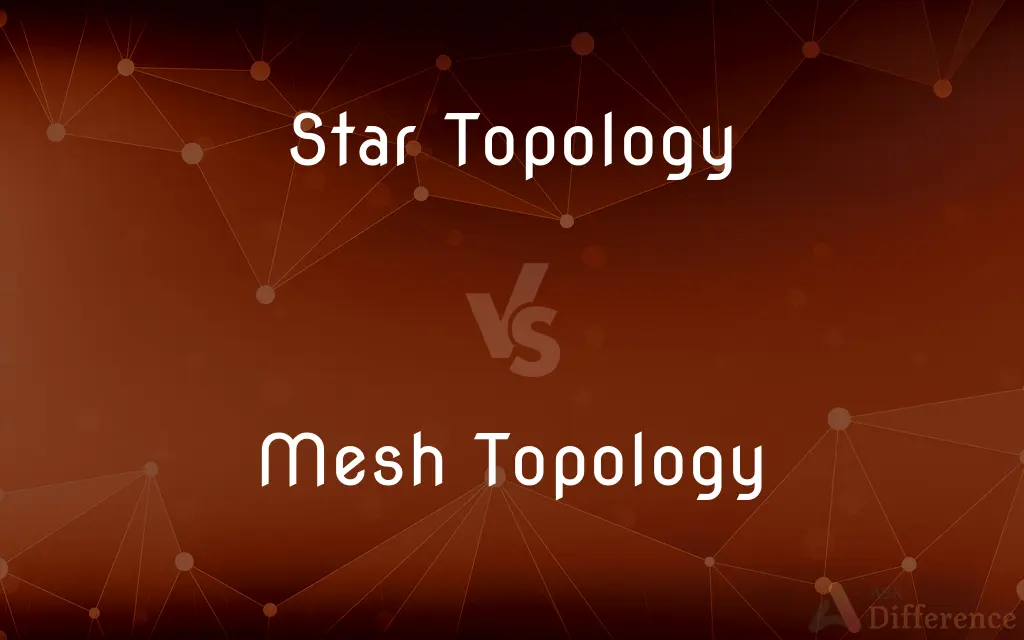Star Topology vs. Mesh Topology — What's the Difference?
By Tayyaba Rehman — Published on January 11, 2024
Star topology involves network nodes connected independently to a central hub, while mesh topology features nodes interconnected directly with each other, often creating a redundant network.

Difference Between Star Topology and Mesh Topology
Table of Contents
ADVERTISEMENT
Key Differences
Network Design: In star topology, each node (like a computer or device) is connected to a singular central hub or switch. Mesh topology, however, involves each node being connected to multiple other nodes, creating a network with numerous interconnections.
Reliability and Fault Tolerance: Star topology can be less reliable; if the central hub fails, the whole network goes down. Mesh topology offers high reliability and fault tolerance since multiple pathways exist between nodes.
Installation and Maintenance: Setting up a star topology is generally simpler and more cost-effective, requiring less cabling and easier maintenance. Mesh topology is more complex to install and maintain due to its numerous interconnections.
Scalability: Star topology is easily scalable by adding more nodes to the central hub. In contrast, scaling a mesh network can be more complicated and expensive as it requires adding multiple connections for each new node.
Performance and Speed: In a star topology, the central hub can become a bottleneck, limiting performance. Mesh topology can offer better performance as data can travel through multiple paths, but the network complexity can sometimes slow down data transmission.
ADVERTISEMENT
Comparison Chart
Network Design
Nodes connected to a central hub
Nodes interconnected with each other
Reliability
Less reliable, dependent on central hub
Highly reliable, multiple pathways
Installation
Simpler, cost-effective
Complex, higher installation cost
Scalability
Easily scalable with central hub
Complex and costly to scale
Performance
Can have bottlenecks at hub
High performance, but can be complex
Compare with Definitions
Star Topology
Commonly used in home and small office networks.
Most home routers create a star topology for connected devices.
Mesh Topology
Ideal for large-scale and critical applications.
Mesh topology is crucial for our large-scale, mission-critical network operations.
Star Topology
A network topology where each node is connected to a central hub.
Our office network uses a star topology for easy management.
Mesh Topology
Offers enhanced performance and fault tolerance.
Our mesh network handles high data volumes efficiently due to multiple paths.
Star Topology
Vulnerable to the failure of the central hub.
When the central hub malfunctioned, the entire network went down.
Mesh Topology
A network topology where each node connects directly to multiple others.
Our data center's mesh topology ensures there's no single point of failure.
Star Topology
Offers easier problem identification and maintenance.
Troubleshooting is more efficient in our star topology network.
Mesh Topology
More complex and expensive to install and maintain.
Setting up the mesh topology was an investment, but it's worth the reliability.
Star Topology
Simplifies the network layout and cable installation.
Setting up our network was straightforward thanks to the star topology design.
Mesh Topology
Provides high reliability with multiple pathways for data.
The mesh topology allows for continuous operation even if some connections fail.
Common Curiosities
Is star topology good for large networks?
Star topology is better for smaller networks; large networks might face performance issues.
What is a mesh topology?
A mesh topology features a network where each node is connected to multiple other nodes.
What is a star topology?
A star topology is a network design where each node is connected to a single central hub.
How does fault tolerance compare in star and mesh topologies?
Mesh topology has higher fault tolerance; in star topology, if the central hub fails, the network goes down.
Are mesh networks more expensive than star networks?
Yes, mesh networks typically require more cabling and complex setup, making them more expensive.
Which topology is easier to set up and manage?
Star topology is generally easier to set up and manage.
Is mesh topology suitable for wireless networks?
Yes, mesh topology is often used in wireless networks for its robustness and range.
Which topology is more reliable, star or mesh?
Mesh topology is more reliable due to its multiple interconnected paths.
How scalable is mesh topology?
Mesh topology is scalable but can become complex and costly as more nodes are added.
Does star topology support high-speed data transmission?
It supports high-speed transmission but can be limited by the capacity of the central hub.
Can mesh topology handle network congestion better than star topology?
Yes, due to multiple paths, mesh topology can handle congestion and maintain performance.
What happens if a node fails in a star topology network?
If a non-central node fails in a star topology, it doesn't affect other nodes. If the central hub fails, the entire network goes down.
Which topology is better for a home network?
For most home networks, star topology is sufficient and more cost-effective.
Are there any security advantages of mesh topology over star topology?
Mesh topology can offer better security due to its complex pathways, making it harder to compromise.
Can I convert a star topology to a mesh topology?
Converting to mesh topology is possible but requires significant changes to the network infrastructure.
Share Your Discovery

Previous Comparison
TCP/IP Model vs. OSI Model
Next Comparison
Denaturation vs. RenaturationAuthor Spotlight
Written by
Tayyaba RehmanTayyaba Rehman is a distinguished writer, currently serving as a primary contributor to askdifference.com. As a researcher in semantics and etymology, Tayyaba's passion for the complexity of languages and their distinctions has found a perfect home on the platform. Tayyaba delves into the intricacies of language, distinguishing between commonly confused words and phrases, thereby providing clarity for readers worldwide.
















































